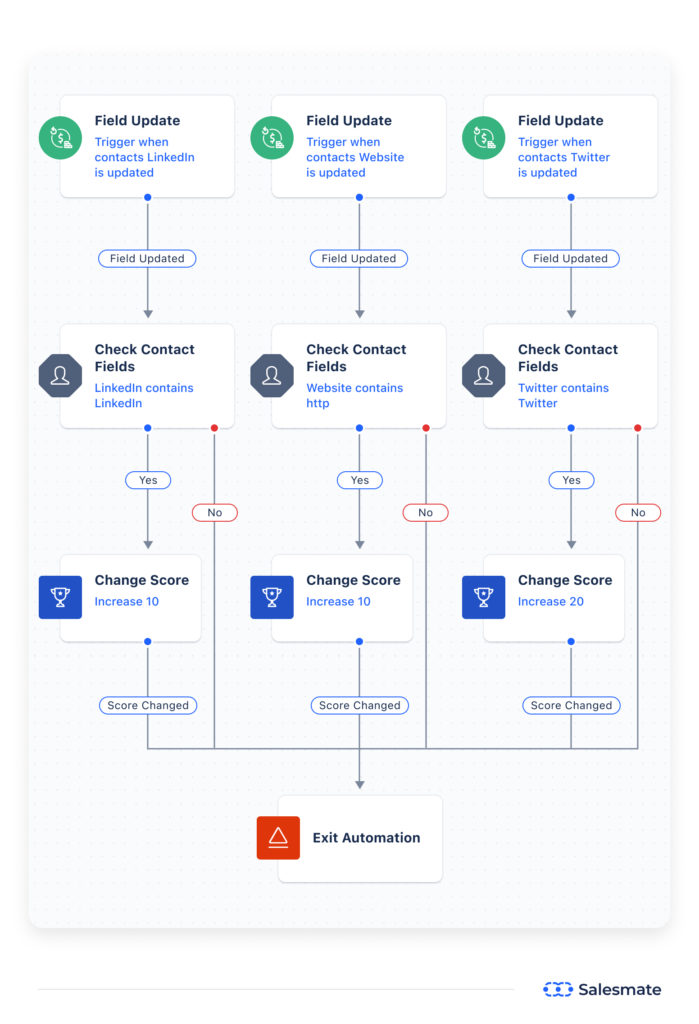Company culture is the personality of your business. This includes how employees interact with customers, how leaders treat employees, and how you behave as a brand towards customers.

This includes everything from the first time a customer hears about you to the time they engage in your product or service to after they have left an interaction with you. Your customer experience must be memorable and pleasant throughout each step of the process.
How do you know if your customer experience is good? Collect data! Using data, marketers can measure statistics like conversion rates, retention rates, average spending amounts, and more. Then, they can use this data to improve their customer experience.
The customer journey refers to all the touchpoints along a person’s path to becoming a customer and, eventually, a loyal customer. During this journey, several steps need to be met for someone to become a repeat customer and advocate for your company.
The consumer experience is what people remember about interacting with your brand after their first purchase or interaction has ended. It’s how they feel about your brand after doing business with you and how likely they are to buy from you again.
Consumer expectations are what consumers think about when considering interacting with you or buying from you again. For example, when someone thinks about buying, they expect fast and free shipping options. You may have consistently built up consumer expectations over time by providing those services.
They think it’s an overhyped and overpriced strategy that doesn’t help their bottom line. However, that couldn’t be further from the truth. CRM can be the difference between a business thriving or floundering. Businesses that have used customer relationship management to their fullest potential have seen incredible growth in profits and revenue.
By following the seven C’s of customer relationship management, companies have increased their sales by 25% on average. Why? Because they’ve focused on their customers.
Businesses use this data to improve their customer experience over time to attract new customers and keep their existing ones happy. This is because customer relationship management is a strategy for everybody! It doesn’t matter how big or small your company is – you can use CRM to improve your bottom line.
WalkMe pioneered the Digital Adoption Platform (DAP) for organizations to utilize the full potential of their digital assets. Using artificial intelligence, machine learning and contextual guidance, WalkMe adds a dynamic user interface layer to raise the digital literacy of all users.
Copyright 2024 Vtiger. All rights reserved. Various trademarks held by their respective owners. | Privacy Policy | Terms of Services | Security Center | Policy & Legal Center | GDPR Readiness | Cookie Policy | Sitemap
Vtiger One Growth edition is ideal for entrepreneurs and SMEs, offering a user-friendly CRM that's easy to set up, tailored for startups and small to medium-sized enterprises.
AI is already saving us time, while also leading us to content and products tailored for us. Learn more about the power of AI in Sales.
In this CRM 101 basics guide, we will review what a workflow is, what the best practices to keep in mind while designing workflow automation for your business.
CRM is the heart of any business. CRM can help drive sales, support marketing activity and boost productivity but how do you go from the initial CRM discussions to CRM implementation and then on to using your CRM to improve your business?
Driven by a passion for Customer Relationship Management (CRM), SuperOffice makes award winning CRM software for sales, marketing and customer service. As the leading European CRM provider, SuperOffice is trusted by thousands of growing companies.
Looking for CRM best practices or some new inspiration around the topics of Sales, Marketing and Customer Service? You've come to the right place. Feel free to browse and download whatever peaks your interest.
Choosing a CRM system is a big decision for any organization, whether you’re starting your first implementation, switching out point solutions, or performing a cross-departmental replacement. But the process doesn’t have to be a daunting challenge that keeps you up at night.
This resource is brought to you by Spreadsheet.com, the spreadsheet you know with the power of a database, built-in project management, no-code automations, integrations, and real-time updates.
Best CRM For Real EstateCustomer Relationship Management, or CRM, is a software that helps companies manage their relationship with customers. These can range from simple tools that help with communications to feature-rich platforms that track all customer activity and help manage your entire sales process.
CRM systems were designed to help companies manage customer interactions. Any department in an organization can use a CRM, but they’re most commonly used by sales, business development, recruitment, marketing, and customer support teams.
The purpose of a CRM is to streamline customer interaction processes and optimize efficiency. Spreadsheet.com’s Simple CRM template helps companies support their clients throughout all of their interactions, from acquiring a customer lead all the way to ensuring their satisfaction after they have purchased your services.
CRM platforms make it easy for different departments to share information about their client interactions across the organization, as all the data can be made available on a single dashboard.
CRM systems have come a long way in the last seven decades. Businesses and technology have seen these tools evolve from Rolodexes and mainframe systems into fully automated AI-powered software platforms.
The first mainstream customer management systems emerged in the 1950s. The Rolodex, invented by Danish engineer Hildaur Neilsen, was a flip-through desk tool containing written customer information, much like a diary.
In the late 80s, contact management software was introduced as the first form of database marketing. Developed by Conductor Software, Activity Control Technology (ACT) was initially created for manufacturing industries to track customer and prospect details in one centralized location.
The 90s saw the birth of sales force automation, pioneered by technologist Tom Siebel. The term “CRM” was likely first coined in 1995 by the Gartner Group. Around the same time, CRM systems emerged as online SaaS products. One of the first examples was the Siebel Sales Handheld, launched in 1999.
From the early 2000s until now, the industry has seen an explosion of technology and the proliferation of software providers. Salesforce’s cloud-based CRM achieved rapid success and dominated the decade. Today, the CRM marketplace is saturated by products from numerous companies like HubSpot, Zoho, SAP, Oracle, and many others.
Today’s CRM platforms integrate business tools into their workflows to make customer relationships a core part of businesses. Since the late 2000s, software providers have integrated social media data into their products, and more recently, platforms have started integrating AI capabilities to provide users with more comprehensive insights.
CRM platforms are centralized repositories of customer data. Because of that, CRM systems are indispensable tools for in-house and remote teams. Since every customer interaction is tracked and recorded, marketing and sales teams can operate more efficiently by making data-driven decisions.
Automating repetitive tasks gives employees more time to work on other valuable projects like strategic decision-making, creative work, and empathizing with customers to provide better services. Employees remain more engaged and productive by focusing on these types of projects. Across every industry, automations are transforming jobs and positively impacting the efficiency of organizations.
As companies scale, their contact databases grow. Segmenting these customer lists manually based on specific requirements is labor-intensive and consumes numerous productive hours. By adopting CRM tools, companies can automatically segment their contact lists based on specific criteria and obtain invaluable data insights.
Database segmentation features in CRM systems allow sales teams to optimize their daily schedules and prioritize tasks related to their key prospects. With sales dashboards, teams can discover new opportunities for upsells and cross-sales. Companies can configure their CRM systems to alert their support team about clients’ requests and needs so they can address them before they turn into potential issues.
Planning future tasks and targets is significantly simpler and more effective when companies can use insights from their past data. Historical metrics and trends can help uncover valuable insights and assist sales teams in prioritizing accounts and forecasting more accurately.
A CRM platform is much more than a fancy electronic Rolodex. When you work with the right software, its features will allow you to seamlessly manage the entire customer lifecycle.











0 تعليقات
We love comments! We appreciate your queries but to protect from being spammed, all comments will be moderated by our human moderators. Read our full comment policy.